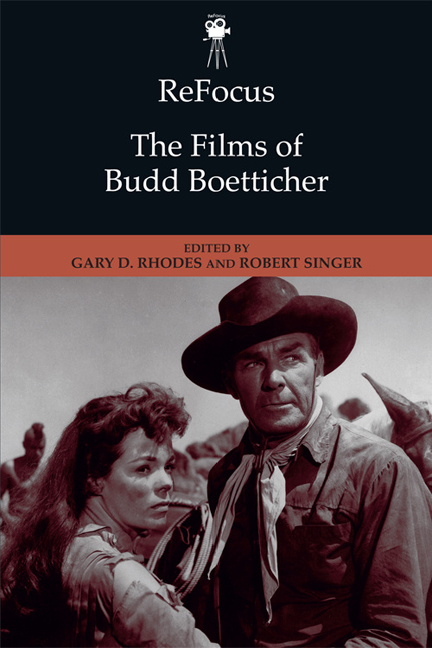Book contents
- Frontmatter
- Contents
- Notes on Contributors
- Dedication
- Introduction
- Part 1 The Non-Westerns
- Part 1 Introduction
- 1 “I never did think he was crazy”: Mystery and Criminality in Boetticher's Psychological Noirs
- 2 On Ethics and Style in Bullfighter and the Lady (1951)
- 3 Domestic Tension and Male Hysteria: The Killer is Loose (1956)
- 4 The Killer is Loose (1956) and the Televisual Dissolution of Film Noir
- 5 Adventures on the Small Screen: Boetticher, Warner Bros., and Maverick
- 6 The Signifying Heel: Boetticher's The Rise and Fall of Legs Diamond (1960)
- Part 2 The Westerns
- Index
5 - Adventures on the Small Screen: Boetticher, Warner Bros., and Maverick
from Part 1 - The Non-Westerns
Published online by Cambridge University Press: 22 December 2017
- Frontmatter
- Contents
- Notes on Contributors
- Dedication
- Introduction
- Part 1 The Non-Westerns
- Part 1 Introduction
- 1 “I never did think he was crazy”: Mystery and Criminality in Boetticher's Psychological Noirs
- 2 On Ethics and Style in Bullfighter and the Lady (1951)
- 3 Domestic Tension and Male Hysteria: The Killer is Loose (1956)
- 4 The Killer is Loose (1956) and the Televisual Dissolution of Film Noir
- 5 Adventures on the Small Screen: Boetticher, Warner Bros., and Maverick
- 6 The Signifying Heel: Boetticher's The Rise and Fall of Legs Diamond (1960)
- Part 2 The Westerns
- Index
Summary
Budd Boetticher's 1957 involvement with Warner Bros., the ABC television network, and the first three episodes of the Western series Maverick grew out of one of the great push–pull stories of Hollywood business during the 1950s: movie studios’ simultaneous loathing for, and attraction to, television. With a landmark 1948 ruling (U.S. v. Paramount Pictures, et al.), the United States Supreme Court forced Paramount, 20th Century-Fox, RKO, MGM, and Warner Bros. to divest themselves of the theater chains that guaranteed profitable exhibition of their products. In addition, the industry's socalled mini-majors, Universal and Columbia, had to join the others and cease the practice of block booking by which theater chains were obligated to accept set numbers of a studio's films, and screen them for predetermined periods.
The court's decision ended the studios’ vertically integrated—and monopolistic— business model that gave absolute control of production, distribution, and exhibition. Henceforth, major studios would be obligated to negotiate exhibition on a film-by-film basis. This change unlocked screens from guaranteed bookings that ate up weeks and months of every booking year. The small studios—Disney, Republic, Monogram/Allied Artists, and Eagle- Lion—benefited. Independent producers got the exhibition foothold they needed to survive, with opportunities to find bookings in big-capacity downtown houses instead of scrabbling for screen space in small urban grind houses, neighborhood theaters, “hardtop” venues located in the sticks, and drive-ins.
Simultaneous with the Supreme Court decision was the changing nature of American moviegoing. In 1946, 61 percent of Americans took themselves to the movies more than once a month. By 1955, the figure had plummeted to 26 percent. Even as postwar inflation forced studios to spend more money than before to make and market movies, everyday citizens felt obliged to limit discretionary spending. Box office receipts slid further. Inflation eventually eased but American entertainment habits seemed to have undergone permanent change. Television was free. You didn't have to dress up to enjoy it, and with four networks, entertainment choices were plentiful.
As is well known, the big Hollywood studios fought back with spectacle and technical innovation. Studio executives became preoccupied with biblical and other large-canvas historical films, and trotted out CinemaScope, VistaVision, Cinerama, 3-D, and stereophonic sound. Many individual pictures employing these innovations were profitable but, because the processes were expensive to develop and implement, overall studio profits dipped precariously.
- Type
- Chapter
- Information
- ReFocus: The Films of Budd Boetticher , pp. 75 - 101Publisher: Edinburgh University PressPrint publication year: 2017

